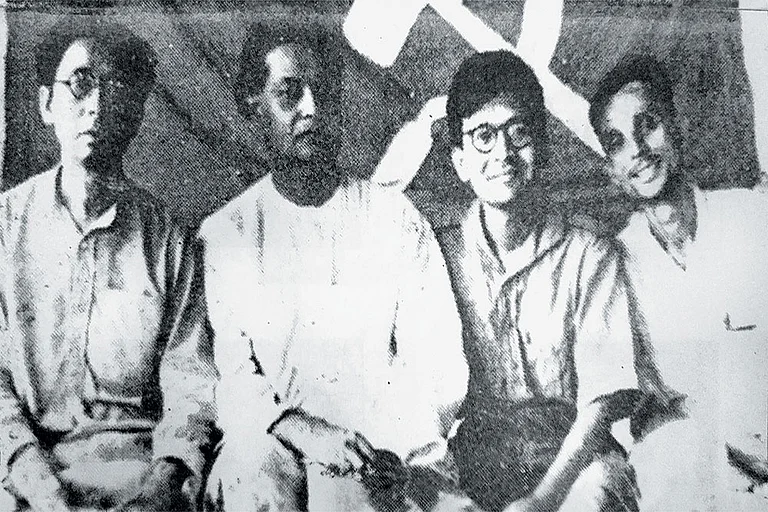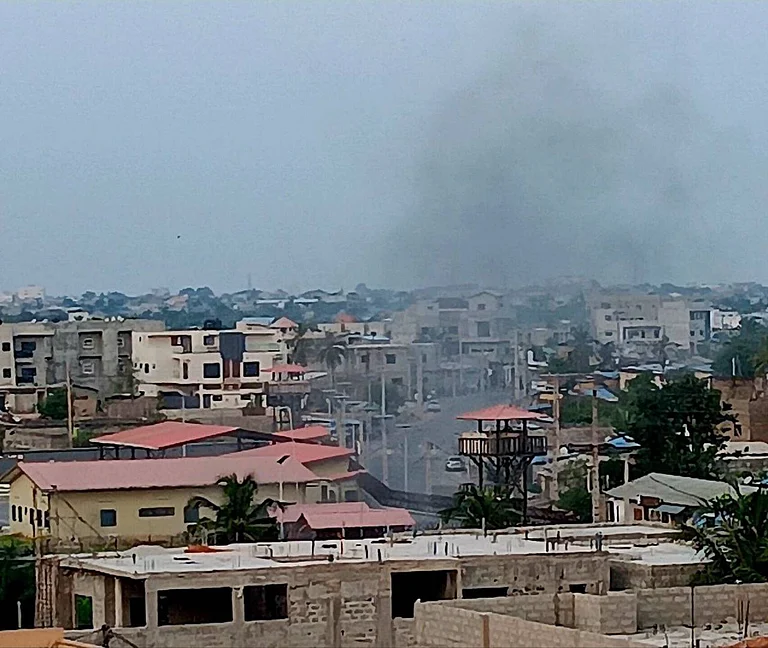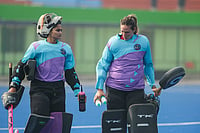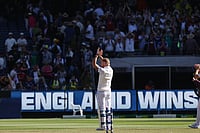‘A city where peacocks were dancing along with cuckoos by the side of ponds which were filled with the fragrance of blossoming flowers’
—Description of ‘Mangalapua’ (Mangalore) in an 8th-century Velvikudi inscription
The port city of Mangalore lies on the Southwest Coast of India, adjoining the Arabian Sea and surrounded by two rivers—Netravati in the south and Phalguni in the north. According to marine geologists, about 11,700 years ago, the coastal region was about 30 Kms further towards the west in the sea from the present seashore. They believe a portion of land was under the sea. The present coastal land in Mangalore city was formed after the sea water receded.
This geological phenomenon might have prompted the creation of a myth that this coastal land, traditionally known as Tulunadu, is the ‘creation of Parashurama, the sage’.
The word ‘Manganour’ appears in the record of Ptolemy (100-170 CE), the Greek geographer and traveller. Scholars believe it’s the present ‘Mangalore’. In his travelogue, Greek traveller Cosmas Indicopleustes (6th CE) mentions ‘Mangarouth’, the port on the West Coast of India, as a “popular port for the export of pepper.” The writings of Indicopleustes give references to trade exchanges between Greece and South India. ‘Mangarouth’ was one of the ports for sea trade during that time.
‘The Royal City’
As per the written historical records, ‘Tulunadu’ (Tulu country), with ‘Mangaluru’ as its capital, was ruled by kings of the Alupa dynasty from about the beginning of 7th CE to 14th CE. The name Mangaluru used to appear in inscriptions during the rule of the Alupa kings. An inscription written during the reign of Alupa 1 at Maruturu (presently at Guntur, Andhra Pradesh) dated 598-599 CE, mentions the name ‘Mangalapura’. Scholars confirm it is the same as ‘Mangaluru’.
The name was also mentioned in the inscription of Udyavara during the period of Alupa King Chitravahana 2. Mangaluru was the capital of the Alupa kings in 7th-8th CE.
Ibn Battutah (1304-1368), the Muslim scholar and traveller from Morocco, visited Barcelore (Basrur) and Fakanur (Barkuru) in January 1335 and came to Mangalore. Battutah describes his Mangalore visit as: “Three days after leaving Fakanur, we reached Manjarur (Mangalore), a large town on the largest inlet in the land of Mulaibar. This is the town at which most of the merchants from Fars (Persia) and Al-Yaman disembark, and pepper and ginger are exceedingly abundant there. The sultan of Manjarur is one of the principal rulers in that land, and his name is Rama Daw. There is a colony of about four thousand Muslims there, living in a suburb alongside the town. Warfare frequently breaks out between them and the town people, but the sultan makes peace between them on account of his need for the merchants.”
Jewish businessman Abraham Ben Yiju travelled from Tunisia, North Africa, to India and settled in Mangalore from 1132-1149. Apart from his import-export business, he also owned a bronze-ware factory in Mangalore. He struck business partnerships on a tremendous economic scale with his Jewish colleagues in Aden and Egypt, ventures that had interconnecting links with Jewish and non-Jewish merchants—Hindus, Muslims and Christians—from North Africa to India. He has written a number of letters to his business partners and received letters of reciprocation regarding the export-import of goods.
Yiju wrote in a letter dated October 17, 1132: “In the city of Manjarur which is in the land of India in Tuluva of Malibarat, the royal city ... on the shores of the Great Sea.” Malibarat refers to the Malabar Coast.
He married a local slave girl ‘Ashu’ in Mangalore and had three children. He also released a Tuluva slave man ‘Bomma’ and made him his assistant in business activities. Yiju used to export metallic vessels to Aden. All the correspondence of Yiju, which was originally in the Arabic language in Hebrew script, was translated into English and published in two volumes—India Traders of the Middle Ages: Documents from the Cairo Geniza (India Book) by SD Goitein and Mordechai A Friedman; 2011.
Important Sea Trade Centre
The Mangalore port was an important sea trade centre. Yiju used to export pepper, areca/betel nut, spices, perfumes and iron goods. Gold, silver, silk, glass, paper, soap, sugar, raisins, cotton cloth, muslin cloth, cheese, olive oil, etc were imported.
Yiju also used to import raw iron, copper and tin sheets from Aden. He would use these to make vessels, utensils, lamps and plates in his bronze factory and used to export them. He left Mangalore with his family in 1149. He first went to Yemen and then settled in Egypt. Settlements of Jews in Kerala and Mumbai are documented, but there are no Jews in Mangalore now. In 1448, Abdul-er-Razzak, an ambassador from Persia, landed in Mangalore on his way to the court of Vijayanagara. He states in his travel account that at a distance of 12 mile from Mangalore he saw a temple with an idol made up of gold with eyes made composed of two red rubies.
Duarte Barbosa, a Portuguese writer and officer who visited Mangalore in 1514, describes it as a very large town, populated by Moors (Muslim merchants) and Gentiles (local merchants) who shipped rice and pepper. He was struck by the beauty of the site and the fine buildings.
The rulers of the Vijayanagara Dynasty (1336-1646), with Hampi as their capital, had their jurisdiction of the West Coast region of Tulunadu. Their officials, also called Governors of Mangalore province, were administering the political and economic activities of the region with Mangalore as its capital. So, the port of Mangalore was under the control of Vijayanagara rulers and it was the main entrance to their kingdom from various foreign countries for trade and commerce.
The rulers of Keladi (Ikkeri), 1550-1763, had political control over the West Coast region with Mangalore as its headquarters. During the regime of the Vijayanagara and Keladi rulers, a Jain dynasty, Bangas, had their capital in Mangalore. They were sometimes subservient and sometimes autonomous in relation to the kings of the Vijayanagar and Keladi dynasties.
In 1448, Abdul-er-Razzak from Persia wrote in his travel account that in Mangalore he saw a temple with an idol made up of gold with eyes composed of two red rubies.
Witness to Many Battles
Mangalore witnessed a number of battles between local rulers, Keladi Nayaka rulers, Banga kings and invading businessmen or administrators, who were mainly Portuguese and British. Queen Abbakka of the Chouta dynasty of Jain religion who was ruling from Ullala, at the southern edge of Mangalore, fought against the Portuguese army in the middle of the 16th century. Queen Abbakka was the first woman who fought against foreign invasion in coastal Karnataka.
The Portuguese came to Goa in 1510 and made it their colony. They made trade agreements with the Vijayanagara kings. They captured the power of levying tax on the export of goods in Mangalore port. The Portuguese laid themselves out to destroy the Arab and Moplah (local Muslims) trade along the coast. In 1526, under the viceroyship of Lopes Vas de Sampayo, Mangalore was taken possession of, after slight resistance from Muslim merchants.
The Portuguese levied in kind—back then, it used to be 2,400 loads of rice and 1,000 measures of oil—for all the transport at Mangalore Port. After the fall of the Vijayanagara Empire in the beginning of 17th CE, the Portuguese captured the forts and ports of the West Coast Canara region.
Turf Wars
The spread of Christianity was another agenda during the Portuguese domain. The Portuguese were in the habit of seizing every ship (vessel) which left the Canarese port without a Portuguese pass. The Arabs retaliated in every way they could and succeeded in burning down forts in Mangalore in 1695.
Hyder Ali came in contact with the Portuguese and tried to get control of West Coast ports, mainly Mangalore. When the first Anglo-Mysore war started, the British army captured Mangalore port and destroyed the naval base of Ali. The Portuguese indirectly helped the British invaders. Battles broke out between Ali and the Portuguese, which resulted in success for Ali. He built a strong Naval Army in Mangalore.
During the second Anglo-Mysore war (1780-1784) Tippu Sultan, Ali’s son, attacked the British to capture the Mangalore port. In 1783, an accord was signed between Tippu and the British Army, which resulted in Tippu having sovereignty over Mangalore. After the death of Tippu in 1799, Canara, the West Coast region, came under the colonial jurisdiction of the British in the name of the ‘English East India Company’. On February 1, 1800, Captain Munro (later Sir Thomas Munro) assumed charge as the ‘Collector’ of Canara district with Mangalore as capital under the Madras Presidency. Mangalore port prospered during British rule. Bundar, the Arabic word for ‘port’, which was used since the entry of Arab merchants, is used even today.
Rice was the major commodity exported from Mangalore port in the 19th century. It was exported to Muscat, Goa, Mumbai, Malabar (Kerala) and England. Other goods exported from Mangalore port during that period were pepper, areca, spices, turmeric, tobacco, sandalwood, coconut, timber, etc.
The scenario of multiplicity of languages in Mangalore happened due to migration of different ethnic groups in various phases in the history of the port city.
Home To Different Communities
The trading community in the 19th century in Mangalore was with many guilds, depending on their origin, names of their communities and languages. Muslim traders were Bearys, Navayaths and Mapillas. Konkanis (Gowda Saraswath Brahmins) were predominantly Hindu businessmen, especially in the Bundar area. The region adjoining the old port in Mangalore is called ‘Bunder’ even now. Traditionally, Bearys (Muslims) and Konkanis (GSBs) were the two major communities occupying the ‘Bundar’ for business purposes. There were Parsis, but now only traces of them exist.
The Muslim community in Mangalore consists of various ethnic groups, most of them engaged in trade and commerce. Beary is the major group among the Muslim population in the West Coast region centering Mangalore. The proposition by scholars is that the ‘Beary’ community evolved with the relationship of Arab traders with local women in different stages of their settlement in the history of Mangalore. The word ‘Beary’ has two derivations—it originated from the word ‘behari’, which means ‘merchant’ and in the Arabic language, ‘Bahaari’ means ‘sea trader’. Since ‘Bearys’ were basically ‘sea traders’, this etymology also holds good.
Other Muslim communities in Mangalore are Memons (from Gujarat), Nawayath (the Konkani-speaking Muslims who mainly came from Bhatkal), Dekhanis (Urdu speakers), Shias and Pusalar. One more trading community that migrated to Mangalore in the early days are ‘Gujarathis’. It was said that Gujarathis came to Mangalore in the beginning by about 1290 CE.
The Present Mangalore
Mangalore was the capital of traditional ‘Tulunadu’ (Tulu Country) from the beginning of the Christian era. Later, when the British came to the West Coast, they named the region as ‘Canara’ with Mangalore as its headquarters. In 1859, the district ‘Canara’ was divided into ‘South Canara’ and ‘North Canara’. Mangalore became the headquarters of ‘South Canara’ under the Madras Presidency. Even after Indian independence in 1947, ‘South Canara’ continued under the Madras Presidency. It was on November 1, 1956, when the linguistic state reorganised South Canara and was merged with the then ‘Mysore State’, which was later called ‘Karnataka State’. Now the district ‘South Canara’ is renamed as ‘Dakshina Kannada’.
Plurality Of Ethnic Groups And Languages
Tulu is the language exclusively confined to this region. Comparative Dravidian Linguists have confirmed that Tulu as an independent language emerged from the Proto-Dravidian Languages family about 2,300 years ago.
Tulu is spoken as the mother tongue by natives belonging to more than forty communities. Since Kannada rulers belonging to dynasties like Alupas, Hoysalas, Vijayanagara kings and Keladi Nayakas ruled this region for centuries together, Kannada was the administrative language and most of the available inscriptions are in Kannada.
Migratory communities brought their languages, like Konkani, to Mangalore. Roman Catholic Christians migrated to Mangalore in several phases from North Goa from the 16th century onwards. The Milagres Church was built in 1680.
The GSBs migrated from South Goa in several phases starting from 1660. They established the temple of their community god Venkataramana in Mangalore in 1776.
Many smaller communities arrived in Mangalore as well. Chitrapura Saraswat Brahmins were prominent as they pioneered in writing Kannada literature. Many of them served as teachers, lawyers, judges and accountants. Bearys, the Muslim community, had developed their own language, which has retained its identity as an independent language. Many Malayalam-speaking communities from the present Kasaragod region also migrated to the Mangalore area. Those involved in weaving, oil-pressing and toddy-tapping speak different dialects of Malayalam and they live in and around Mangalore. Brahmins of different sects living here have different mother tongues. Marathi and Chitpavan-speaking Brahmins and Urdu- speaking Muslims are also found here.
Christian missionaries from the Basel Evangelical Mission came to Mangalore in 1834 and started primary schools, printing presses, weaving factories, and tile factories. They branded the name ‘Mangalore Tile’ which became popular in South India. The missionaries engaged in conversion mainly from Tulu- speaking communities like Billavas, Bunts and Mogaveeras. So, Tulu became the mother tongue of this section of Christians, who are generally known as Protestants or popularly ‘Mission people’.
The scenario of multiplicity of languages in Mangalore is not a modern phenomenon as a result of cosmopolitanism. This happened due to migration of different ethnic groups in various phases in the history of Mangalore. What’s interesting is that Tulu is still the native language.
(Views expressed are personal)
MORE FROM THIS ISSUE
B A Viveka Rai has served as Vice-Chancellor of Kannada University, Hampi




























